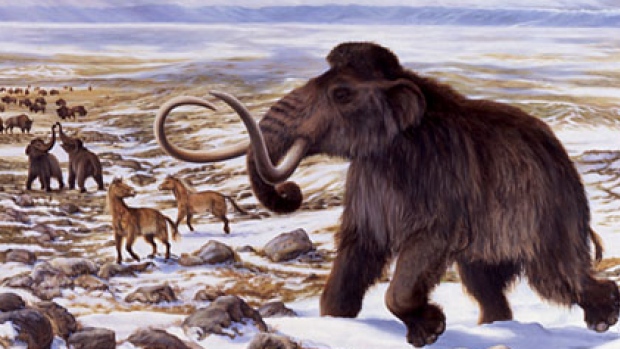Pleistocene Epoch was host to large animals called megafauna-todays megafauna include elephants, giraffes, rhinos, and hippos. During Pleistocene this list was much larger including wooly rhinos, giant sloths, saber-toothed tigers, and the more famous wooly mammoth. The mammoth has come to be the mascot of de-extinction, the one that grabs the attention of everyone, the one everyone asks about. This proboscidean was front and center on the April 2013 National Geographic about de-extinction. Molecular ecologist, Beth Shapiro, named her book “How to Clone a Mammoth,” stating in the prologue that this is the most common question she is asked. She choose this title for the book and it was about the entire science of de-extinction and the mammoth is actually a very difficult candidate for de-extinction, at least at this time. It is a great thing that there is a mascot for the science, the idea of the pre-historic giants roaming the Earth again absolutely fascinates everyone, scientists and non-scientists.
This is a scientific based website, so….
What are the scientific benefits to bringing back the mammoth?
Just north of Siberia sits Pleistocene Park, the owner Sergey Zimov is concerned with bringing back the lost Pleistocene steppe. He is already transforming a seemingly melting wasteland, permafrost, into a thriving ecosystem. He has introduced a few extant mammals to his park and they are really showcasing how needed mammals are in ecosystems, the fauna (animals) and flora (plants) of the park are doing much better. However, there are still some pieces missing from his park. He lacks apex predators and large megafauna. Zimov, so heavily believes that the megafauna are crucial to the land that his vehicle of choice is a old beaten down war tank-yes, a war tank! Mammoths were very good at clearing paths, shoveling snow, packing and loosing soil, and transporting seeds. His tank is also very good at this. However, he claims that his tank does not have the…umm…fecal qualities of the mammoth; mammoths were believed to have microbial bacteria in their intestines which could germinate and shape seeds very well. Also, as we know dung makes a very good fertilizer and 13,000 pound mammoths definitely produce their share of it. The steppe evolved with mammoths (and many other extinct or displaced species) and most definitely requires them to be fully functioning.
So, just how do you clone a mammoth?
When you think of cloning, you think of like a Xerox machine. Here is something and we will make a duplicate. Well, we do not have a mammoth to put on our Xerox machine. But, we do have mammoth aDNA and asian elephants. Studying the aDNA of wooly mammoths, scientists are finding various genes specific to the adaptations of the species; such as: the wooly coat, the 2-inch layer of insulating fat, the enormous tusks, and a special hemoglobin, which is better suited to transport oxygen in extremely cold environments. Using various techniques such as, CRISP-R, nuclear transfer, and iPS cells these genes could be encoded into the Asian Elephant genome, thus producing an elephant possessing mammoth adaptations.
If it walks like a mammoth, looks like a mammoth, acts like a mammoth…
…Is it a mammoth?
Well, this answer is debatable and up to negotiation. The important part is the animal will act like a mammoth, which is crucial to the goal of preserving and reconstructing the Pleistocene steppe. In addition, asian elephants, the closest extant species to the wooly mammoth is running out of real estate and they are frequent member of endangered species lists. This is not to say, we should stop conserving the asian elephant and ship them all up north; but we could, in theory, give some asian elephants the adaptations they need to survive and thrive in Pleistocene Park. It would be like giving the elephants a coat and some hot soup to go explore some new lands and be able to thrive as a species again, to regain that feeling of being an integrate link or component in a natural ecosystem.
